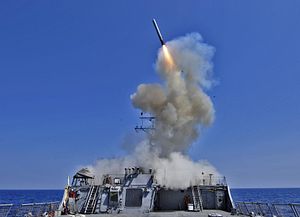On October 4, Japan’s Defense Minister Kihara Minoru announced that Tokyo will acquire hundreds of U.S.-made Tomahawk cruise missiles as early as fiscal year 2025, moving up the original schedule by one year.
The announcement came after the new defense minister talked with his U.S. counterpart, Lloyd Austin, in a 55-minute meeting at the Pentagon. Kihara, who just became defense minister on September 13 amid Prime Minister Kishida Fumio’s cabinet shuffle, is on an inaugural trip to Washington, D.C. this week. He met with U.S. National Security Advisor Jake Sullivan earlier in the day.
“In light of the increasingly severe security environment, we have determined that it is necessary to bring forward efforts to build stand-off defense capabilities,” Kihara told reporters.
The biggest reason behind the move to bring forward the introduction of the Tomahawk in Japan is the increasing risk of an emergency in the Taiwan Strait. There is some speculation within the United States that China could invade Taiwan by 2027.
Japan originally planned to acquire 400 Block V missiles, the latest version of the Tomahawk, in fiscal years 2026 and 2027, to be equipped onto Japan Maritime Self-Defense Force (JMSDF) Aegis-equipped destroyers. But Kihara and Austin decided that the acquisition period need to be brought forward one year. That will involve changing half of those missiles to the Block IV, which is a previous version of the Tomahawk.
The Block IV, which has the same 1,600 km range as the Block V, has been already widely deployed by the U.S. military and is easy to supply to Japan, making it possible to bring forward the acquisition date.
“The Block IV has similar functions in terms of guidance methods and range, and we have concluded that it has sufficient capabilities to defend our country,” Kihara said.
The officially named RGM-109E/UGM-109E Tomahawk Block IV land attack cruise missile – also known as the Tactical Tomahawk – features a longer striking range and improved loitering capabilities when compared with the Block III variant of the missile, according to Janes.
Meanwhile, the Block V Tomahawk missile includes a navigation/communications (NAV/COMMs) package for enhanced navigation performance and more robust and reliable communications when compared with the Block IV.
The Block V variant also provides the entry point for two additional subvariants: the Block Va variant, which adds a seeker kit to enable the targeting of moving maritime targets; and the Block Vb variant, which introduces a new multi-effects lethal package in place of the existing unitary warhead, according to Janes. It is still unclear which Block V variant Tokyo will buy at this stage.
Japan’s Defense Ministry earmarked 211.3 billion yen ($1.4 billion) in this fiscal year’s budget to cover the cost of the missiles and other related expenses. It also asked for 200 million yen to add Tomahawk launch functions to the eight JMSDF Aegis-equipped destroyers for its fiscal year 2024 budget proposal.
First outlined in the 2018 National Defense Program Guidelines, the then Abe Shinzo administration began to acquire stand-off defense capabilities amid growing concerns over North Korea’s continuing nuclear and missile development and China’s aggressive military activities in the East China Sea, including in the sea and airspace around the disputed Senkaku/Diaoyu Islands.
Approved in the three national security documents in December 2022, the current Kishida administration formally decided to acquire counterstrike capabilities by utilizing stand-off defense capabilities, which enable missile attacks from outside the enemy’s threat zone. The core of that plan was a deal to acquire roughly 400 Tomahawk missiles from the United States, starting in fiscal year 2026.
In response to the expiration of the Intermediate-Range Nuclear Forces (INF) Treaty in 2019, which prohibits the possession of intermediate-range (500-5,500 km) ground-launched missiles, the Japanese and U.S. governments had made behind-the-scenes discussions regarding the deployment of intermediate-range missiles to Japan.
However, the deployment of Tomahawk missiles to Japan was postponed due to high political hurdles, including the need for obtaining the understanding of local governments. Instead, the United States decided to set up a battalion tasked with launching land-based Tomahawk missiles within the U.S. Marine Corps’ 11th Marine Regiment based in California by 2030.
Since it is difficult to deploy the Tomahawk to U.S. military bases in Japan, the U.S. apparently wants Japan to possess them on its own.
Japan’s procurement of Tomahawks will require approval from the U.S. Congress.

































